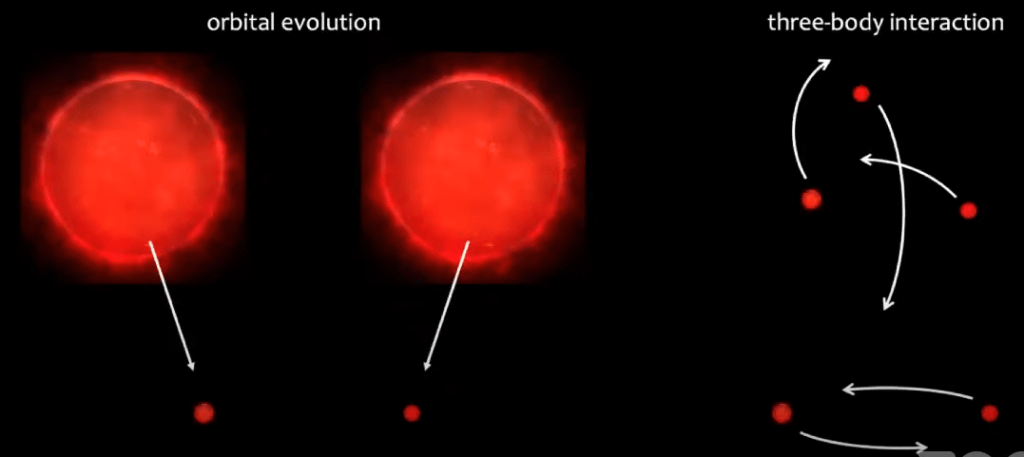A team of astrophysicists has discovered a binary pair of ultra-cool dwarfs so close together that they look like a single star. They’re remarkable because they only take 20.5 hours to orbit each other, meaning their year is less than one Earth Day. They’re also much older than similar systems.
We can’t see ultra-cool dwarf stars with the naked eye, but they’re the most numerous stars in the galaxy. They have such low masses that they only emit infrared light, and we need infrared telescopes to see them. They’re interesting objects because theory shows stars this close together should exist, but this system is the first time astronomers have observed this extreme proximity.
“It’s amazing to see something happen in the universe on a human time scale.”
Professor Adam Burgasser, UC San Diego.
A team of astronomers presented their findings at the 241st Meeting of the American Astronomical Society in Seattle. Chih-Chun “Dino” Hsu, an astrophysicist at Northwestern University, led the research. The system is named LP 413-53AB.
“It’s exciting to discover such an extreme system,” said Chih-Chun “Dino” Hsu, a Northwestern astrophysicist who led the study. “In principle, we knew these systems should exist, but no such systems had been identified yet.”

Nature’s extremes play an important role in calibrating our theoretical models, and that’s true of low-mass binaries. Prior to this discovery, astronomers knew of only three short-period, ultra-cool binaries.
The research team found the pair in archival data. They were combing through data using an algorithm Hsu wrote that models stars based on their spectral data. But in those earlier images, the stars just happened to be aligned, so they appeared as a single star. The chances of that happening are high for a tight binary pair like this. But Hsu and his colleagues thought the data was odd, so they observed the star more closely with the Keck Observatory. The observations showed that the light curve changed so quickly there must be two stars.
Eventually, they realized they had found the closest binary pair ever found.

“When we were making this measurement, we could see things changing over a couple of minutes of observation,” said Professor Adam Burgasser of UC San Diego. Burgasser was Hsu’s advisor while Hsu was a Ph.D. student. “Most binaries we follow have orbit periods of years. So, you get a measurement every few months. Then, after a while, you can piece together the puzzle. With this system, we could see the spectral lines moving apart in real-time. It’s amazing to see something happen in the universe on a human time scale.”
To emphasize just how close the stars are to each other, Hsu compared them to our own Solar System and another well-known system. The pair are closer together than Jupiter and one of its Galilean moons, Callisto. It’s also closer than the red dwarf star TRAPPIST-1 is to its closest planet, TRAPPIST-1b.

The stars are much older than the other three similar systems astronomers know of. While those three are relatively young at up to 40 million years old, LP 413-53AB is several billions of years old, like our Sun.
Their age is a clue that the stars didn’t start out this close to one another. The researchers think they could have started out in an even tighter orbit. “This is remarkable because when they were young, something like 1 million years old, these stars would have been on top of each other,” said Burgasser.
Or the stars may have begun as a pair on wider orbits and then become closer over time. Another possibility is the stars started out as a triple-star system. Gravitational interactions could’ve simultaneously ejected one star and drawn the remaining two into a tighter orbit. More observations of the unique system might help answer that.

Astronomers are interested in stars like these because of what they might tell us about habitable worlds. Since ultracool dwarfs are so dim and cool, their habitable zones are tight regions. That’s the only way they could warm the planets enough to sustain liquid surface water. But in LP 413-53AB’s case, the habitable zone distance is the same as the stellar orbit, eliminating the possibility of habitable exoplanets.
“These ultracool dwarfs are neighbours of our sun,” Hsu said. “To identify potentially habitable hosts, it’s helpful to start with our nearby neighbours. But if close binaries are common among ultracool dwarfs, there may be few habitable worlds to be found.”
Now that astronomers have found one system as tight as this, they want to know if there are more. That’s the only way to understand all these different scenarios. It’s difficult to even approach any conclusions when you only have one data point. But astronomers don’t know if they’ve only found one because they’re so rare or because they’re so difficult to spot.
“These systems are rare,” said Chris Theissen, study co-author and a Chancellor’s Postdoctoral Fellow at UC San Diego. “But we don’t know whether they are rare because they rarely exist or because we just don’t find them. That’s an open-ended question. Now we have one data point that we can start building on. This data had been sitting in the archive for a long time. Dino’s tool will enable us to look for more binaries like this.”
More:
- Press Release: Ultracool dwarf binary stars break records
- YouTube: AAS 241 Press Conference: Stars and Their Activity
- Universe Today: Binary Stars Live Complicated Lives, Especially Near the End
The post Binary Dwarf Stars Found Orbiting Each Other Every 20 Hours. They Were Once Almost Touching appeared first on Universe Today.
from Universe Today https://ift.tt/B4kQhsG
via IFTTT
Comments
Post a Comment